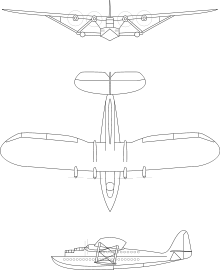Latécoère 521
| Laté 521 "Lieutenant de Vaisseau Paris" | |
|---|---|
 | |
| Role | Civil flying boat |
| Manufacturer | Pierre-Georges Latécoère |
| First flight | 10 January 1935 |
| Primary user | Air France |
| Number built | 5 (1x 521, 1x 522, 3x 523) |
The Latécoère 521, "Lieutenant de Vaisseau Paris", was a French six-engined flying boat, and one of the first large trans-Atlantic passenger aircraft. The four inboard engines were mounted as tandem push-pull pairs.
Operational history
The inaugural flight took place on 10 January 1935, followed by a demonstration flight in December 1935 via Dakar, North Africa to Natal, Brazil, then north to the French West Indies. The inaugural flight was to mark the 300th year of French rule in the Americas. Having reached Pensacola, Florida, it was caught in a hurricane and wrecked.[1] The aircraft was returned to France by ship to be rebuilt for service with Air France on the trans-Atlantic route. In June 1937 it flew non-stop to Natal before returning to France via the North Atlantic. On 30 December 1937 it set an FAI record carrying a payload of 18040 kg (39,770 lbs) to 2000 meters (6,562 ft) altitude at Biscarrosse, France. (The FAI Bulletin says it had six 650-hp (485-kW) engines at the time.) In 1939 the XB-15 set a new landplane payload record: 14135 kg.
Equipped with more powerful engines, the aircraft made four further return flights to New York between May and July 1939. During one of these, pilot Henri Guillaumet flew 5,875 km (3,651 mi) from New York City to Biscarrosse at an average of 206 km/h (127 mph), including 2,300 km (1,400 mi) with one engine out.
The aircraft could transport 72 passengers in a great comfort. On the lower level there was a salon with 20 armchairs and tables, six deluxe double cabins, each with its own bathroom, seating for a further 22 passengers, a kitchen, a bar and a baggage hold. The upper level had seating for 18 passengers, a storage compartment and an office for the three flight engineers.
On the outbreak of World War II the Laté 521 was attached to the French Navy E.6 flotilla, based in Port-Lyautey, Morocco, and was used to patrol the North Atlantic. After the armistice in June 1940 it flew to Berre, near Marseilles, where it was finally wrecked by the retreating Germans in August 1944. The Laté 521 was the basis of the single Laté 522 "Ville de Saint Pierre" civil airliner, and the three Laté 523 navalized variants.
Variants
Data from:[2]
- 520
- The initial design of the 520 series, powered by 4 × 1,000 hp (750 kW) Hispano-Suiza 18Sbr W-18 engines in tandem pairs.
- 521 Lieutenant de Vaisseau Paris
- The first completed aircraft, powered by 6 × Hispano-Suiza 12Ydrs. Operated by Air France on route proving flights the 521 was militarised in 1939 and operated by the Vichy government until stored at Marignane, finally being destroyed when axis troops retreated from advancing Allies.
- 522 Ville de Saint Pierre
- The second aircraft of the 520 series, powered by 6 × Hispano-Suiza 12Y-37 engines, had a brief civilian career before being militarised similar to the 521. Operated by the Ministre des Colonies de Vichy, the 522 met a similar fate to the 521, being destroyed by retreating enemy troops in 1944.
- 523
- Three armed maritime patrol aircraft named l'Algol, l'Aldébaran and l'Altair, operated by Vichy French forces.
- 524
- Projected variant of the 521 to have been powered by 8 × CLM Lille 6As opposed-piston 2-stroke diesel engines.
- 525
- Similar to the 524 but powered by 8x Hispano-Suiza 12Y engines.
Operators
Specifications (Laté 521)

Data from Latécoère[3]
General characteristics
- Crew: 5 + cabin crew
- Capacity: 30–72
- Length: 31.62 m (103 ft 9 in)
- Wingspan: 49.3 m (161 ft 9 in)
- Height: 9.07 m (29 ft 9 in)
- Wing area: 330 m2 (3,600 sq ft) + 53m² (570.5ft²) for the sponsons / lower wings
- Empty weight: 18,882 kg (41,628 lb)
- Max takeoff weight: 40,000 kg (88,185 lb)
- Powerplant: 6 × Hispano-Suiza 12Ydrs V-12 liquid-cooled piston engine, 641.3 kW (860.0 hp) each (final engine fit)
- Powerplant: 6 × Hispano-Suiza 12Ybrs V-12 liquid-cooled piston engine, 570 kW (760 hp) each (interim engine fit)
- Powerplant: 6 × Hispano-Suiza 12N V-12 liquid-cooled piston engine, 484.7 kW (650.0 hp) each (original engine fit)
Performance
- Maximum speed: 261 km/h (162 mph; 141 kn) at 2,000m (6,562ft)
- Cruise speed: 210 km/h (130 mph; 113 kn)
- Minimum control speed: 100 km/h (62 mph; 54 kn)
- Range: 4,100 km (2,548 mi; 2,214 nmi)
- Service ceiling: 6,300 m (20,700 ft)
- Rate of climb: 3.7 m/s (730 ft/min)
- Time to altitude: 2,000m in 9min
See also
Aircraft of comparable role, configuration and era
Related lists
References
- ↑ "Six Motors Drive Big Sea Plane Over Ocean" Popular Mechanics, April 1936
- ↑ Cuny, Jean (1992). Latécoère – Les Avions et Hydravions (in French). Paris: Docavia/Editions Lariviere. pp. 149–168. ISBN 2-90 70 51-01-6.
- ↑ Cuny, Jean (1992). Latécoère (in French). Paris: Éditions Larivière. ISBN 2-907051-01-6.
External links
| Wikimedia Commons has media related to Latécoère 521. |
- Latécoère 521 film
- "Seaplane's Hull Resembles Ship" Popular Science, February 1935
- Popular Mechanics, December 1935 article on Air France with page on the 521
- "Around the World in 10 Days" Popular Mechanics, April 1935, cutaway drawings pp. 568–569